
Trumpeter 1/32 Me-262B-1a/U1
| KIT #: | 2237 |
| PRICE: | $94.95 MSRP |
| DECALS: | Two options (both wrong) |
| REVIEWER: | Tom Cleaver |
| NOTES: |

| HISTORY |
Over the past 50 years, a lot has been written about the Messerschmitt Me-262B-1a/U1, the world’s first jet-powered night fighter. Tales of the two-seat Me-262B shooting down RAF Mosquitos over Berlin in the closing weeks of the war were first spun in the 1960s, but they are nothing but fantasy. Probably the most complete example of this I know of is Ken Merrick’s account in “Messerschmitt Me-262 Described, Vols. 1 and 2" of how “Kommando Welter was equipped with approximately ten Me-262B-1a/U1 night fighters which operated in defense of Berlin.” In fact, as described before, Kommando Welter had approximately ten Me-262A-1a day fighters. More “experts” have produced more drivel about these airplanes, which has been repeated by other experts (copying from one is plagiarism - copying from many is research), until the actual facts are barely visible. Merrick is also responsible for “Red 10,” which only ever existed in a profile in his book, which was then adopted as a “fact” by the “historians.” In fact, the two Me-262B-1a/U1s were marked as “Red 12" and “White 306" - as shown in the photos in his book.
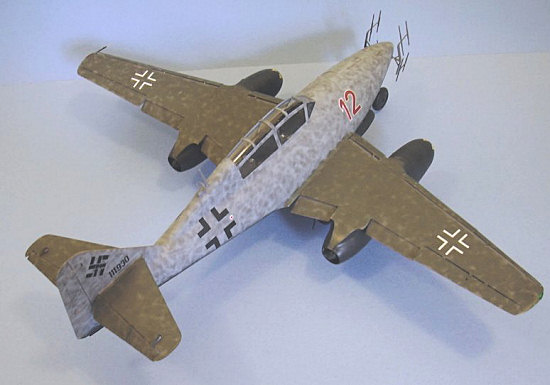 According to my friend
Jorg Czypionka, the last surviving pilot of Kommando Welter - the
night-fighting unit that did use Me-262s - four of the two-seaters did show up
in early April, two of which were equipped with radar. However, since they were
a dedicated Wilde Sau unit, there were no radar operators or technicians
to service the equipment, and there certainly was not enough time to train a
crew. One or two of the Me-262Bs were used in the role for which they had been
originally created - pilot conversion - but the war was coming to a close so
fast in April that the airplanes were little used. The two airplanes are “Red
12" and “White 306"/”Red 8.”
According to my friend
Jorg Czypionka, the last surviving pilot of Kommando Welter - the
night-fighting unit that did use Me-262s - four of the two-seaters did show up
in early April, two of which were equipped with radar. However, since they were
a dedicated Wilde Sau unit, there were no radar operators or technicians
to service the equipment, and there certainly was not enough time to train a
crew. One or two of the Me-262Bs were used in the role for which they had been
originally created - pilot conversion - but the war was coming to a close so
fast in April that the airplanes were little used. The two airplanes are “Red
12" and “White 306"/”Red 8.”
In fact, the only reason these airplanes are known at all is due to the fact that the unit commander, Oberleutnant Kurt Welter, saw the writing on the wall and was determined to use his possession of as many Me-262s as he could lay hands on to assure his men preferential treatment by the victorious Allies when the war came to an end. The airplanes were flown with the rest of the unit up to the Luftwaffe base at Leck in Schleswig-Holstein on the Danish border, where Welter then contacted the British and surrendered his unit and their airplanes intact, the only jet-equipped Luftwaffe unit to do so. Over the course of the summer of 1945, the Luftwaffe veterans trained Allied pilots to fly the Me-262 and helped prepare the aircraft for transfer to their new owners. While engaged in this, Welter made a deal with the commander of a local POW camp for groups of his men to check in for 72 hours and then receive their discharge papers. When the work at Leck came to an end in September and the British apologetically told Welter that he and his men would now have to report to prison camp, the Germans presented their paperwork and were allowed to leave by their chagrined British “captors.”
And that is the true story of the “combat history” of the Me-262B-1a/U1 and its use by Kommando Welter.
This is not to say that the Md-262B-1a/U1 was a bad idea. On the contrary. The airplane so impressed the British and the Americans who obtained them that the two air forces immediately began developing their own two-seat all-weather/night interceptors.
The
Me-262 single-seater was such a handful for most pilots who were familiar with
piston-powered aircraft to operate, that it was considered crucial to create a
2-seat conversion trainer so that pilots could get used to the slow throttle
response of early jets with someone there to demonstrate in flight what they
needed to do. Messerschmitt had suggested development of such a trainer as soon
as the Me-262A-1a was approved for production. The first 2-seat conversion -
designated Me-262B-1a - appeared in the
 fall of 1944. Installation of
the second seat reduced internal fuel capacity and required the attachment of
two 66-gallon drop tanks on the pylons developed for the bomber variant. The
standard armament of four 30mm MK 108 cannon was retained. Approximately 15 of
the trainers were produced before the end of the war and at least two were sent
to KG(J) 54 according to my friend Hans Busch, who flew Me-262 bombers with that
unit.
fall of 1944. Installation of
the second seat reduced internal fuel capacity and required the attachment of
two 66-gallon drop tanks on the pylons developed for the bomber variant. The
standard armament of four 30mm MK 108 cannon was retained. Approximately 15 of
the trainers were produced before the end of the war and at least two were sent
to KG(J) 54 according to my friend Hans Busch, who flew Me-262 bombers with that
unit.
The idea of developing the Me-262 as a night fighter was also an early consideration. An experimental Me-262 equipped with SN-2 “Liechtenstein” was built, but the workload for a single pilot to fly the airplane and interpret the radar was too much. It was then proposed that a dedicated two-seat version - the Me-262B-2a, which would have been approximately 3 feet longer than the standard Me-262, with four MK 108s in the nose and a “Schräge Musik” installation of 2 MK 108s behind the cockpit - be developed, but there was not time for this. Three of the Me-262B-1a trainers were modified by equipping them with FuG 218 radar and additional radio navigation and communications equipment, giving them the designation Me-262B-1a/U1. The first of these conversions crashed on its initial flight, but the other two were sent on to Kommando Welter, where they were never used, as detailed above.
| THE KIT |
Trumpeter’s single-seat Me-262s, released in 2005, were immediately recognized as the best kits of this famous airplane in any scale. The kits came with flaps and slats that could be deployed, something no other Me-262 kit had ever done, and were fully detailed throughout with complete engines and armament.
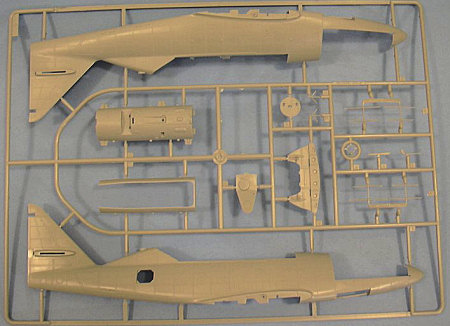 This new kit of the
Me-262B-1a is comparable in quality. It differs from the other kits by coming
with a sprue that has the different fuselage, with the radar array and a 2-seat
cockpit. Otherwise, the rest of the kit is identical to the previously-released
versions.
This new kit of the
Me-262B-1a is comparable in quality. It differs from the other kits by coming
with a sprue that has the different fuselage, with the radar array and a 2-seat
cockpit. Otherwise, the rest of the kit is identical to the previously-released
versions.
Both Hasegawa and Revell have released 1/32 Me-262s in both single and two-seat versions. All of these kits are over 30 years old. Reviewers of the 2005 release of the single-seaters by Trumpeter noted the overall quality improvement of the new kit over these older releases. The same is true here with the Me-262B-1a/U1.
Unfortunately, Trumpeter got it completely wrong with the decals. The two night fighters were “White 306"/”Red 8" and “Red 12.” The kit provides “Red 10" and “Red 11,” both of which are completely spurious, and further claims that “Red 10" is the airplane flown by “Ltn. Kurta Weltera,” with the other being the aircraft allegedly flown by someone I never heard of. Not only that, but the serial numbers are completely spurious, though the good news is that between both numbers, a modeler can piece together the serial for “Red 12". Thus, only the national markings for in the kit are of any use for creating a model of an actual airplane. The painting instructions are as spurious as the identification of the pilots who supposedly flew these airplanes. On this point, it appears to me that Trumpeter’s “markings research” was limited to looking at the decal sheets of the older Revell and Hasegawa releases, which were likely the products of the “make it up if you don’t know it” kind of “research” done too many times in the 1960s and early 1970s, and then copied by others until they became “facts” through proliferation. The painting instructions appear to be based on the spurious “restoration” of “Red 8" by the people who are remanufacturing Me-262s.
| CONSTRUCTION |
The
model presented no difficulties in construction. My only deviation from the
instructions was to discard the very nicely-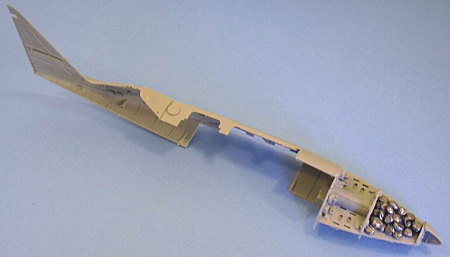 detailed
Jumo 003 engines, using only the exhausts, since the rest of the engine would be
invisible inside the painted nacelles.
detailed
Jumo 003 engines, using only the exhausts, since the rest of the engine would be
invisible inside the painted nacelles.
I built the wing as a sub-assembly, then assembled the fuselage after painting the cockpit RLM66 Schwarzgrau, “popping out” the detail with drybrushed Tamiya Flat Aluminum. I used fishweights in the nose section ahead of the gun bay to weight the nose. I elected not to use the very nice Mk 108 cannons, because my previous experience was that the closed gunbay preserved the dramatic lines of the original. Given that the two-seater is in no way as sleek-looking as the single-seater, I felt it needed all the help it could get in the looks department. When I test fitted the canopy, I realized it was so clear that closing it would still allow a viewer to see the cockpit, while also preserving what sleekness this version has. At this point, it was time to go to the paint shop.
I experienced some difficulty in getting the gun bay doors to close. This is typical of “open” parts on most models, and only requires some test-fitting and sanding along the edges to get a good fit.
| COLORS & MARKINGS |
Painting Notes:
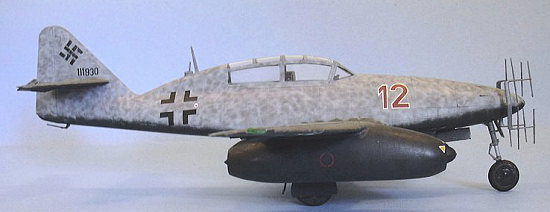 Back in 1998, I had the
opportunity to do a long interview with Jorg Czypionka, who at the time was one
of the last pilots still alive who had flown in Kommando Welter - and who
is now the sole surviving witness to these airplanes when they were
“operational.” Since there has been so much faulty information put out about
these airplanes over the years, I went to great lengths to ask him about the
camouflage of the two Me-262Bs. According to Jorg the airplanes were originally
painted “medium grey” on top (RLM75) and “light blue” on the bottom (RLM76) with
“night fighter scribble” overall, when he first saw them. The wings were then
painted a “dark green” in a “rough finish”, while the undersides of the
airplanes were roughly oversprayed black. According to Jorg, the paint scheme
was mostly to camouflage the airplanes while they were parked in the forest. He
also stated that he had seen “Red 12" at the South African Museum and that it
“looked about right.”
Back in 1998, I had the
opportunity to do a long interview with Jorg Czypionka, who at the time was one
of the last pilots still alive who had flown in Kommando Welter - and who
is now the sole surviving witness to these airplanes when they were
“operational.” Since there has been so much faulty information put out about
these airplanes over the years, I went to great lengths to ask him about the
camouflage of the two Me-262Bs. According to Jorg the airplanes were originally
painted “medium grey” on top (RLM75) and “light blue” on the bottom (RLM76) with
“night fighter scribble” overall, when he first saw them. The wings were then
painted a “dark green” in a “rough finish”, while the undersides of the
airplanes were roughly oversprayed black. According to Jorg, the paint scheme
was mostly to camouflage the airplanes while they were parked in the forest. He
also stated that he had seen “Red 12" at the South African Museum and that it
“looked about right.”
Using this information and looking at the photos taken of these airplanes
shortly after the end of the war, I believe that the airplanes did arrive in RLM
75 Grauviolett upper surfaces with RLM 76 Lichtblau lower
surfaces, with “night fighter finish” of a tight RLM 76 Lichtblau
“scribble” over the fuselage and vertical fin, and probably the upper wing
surfaces. The “rough finish” of the dark green could have likely been another
“big scribble” of dark green. If this was done in the field, it could have been
any color  of dark green
available; I chose to use RLM 71 Dunkelgrun, which was available in the
field up to the end of the war. The nose gear leg appears to be painted, which
I suspect is RLM 02 Grau and could also be a “Messerschmitt Green” that
is close to U.S. Medium Green. The gear door is in shadow and cannot be
confirmed any color, but I think a case can be made that the gear wells could
have been either unpainted natural metal, or RLM 02, with the gear legs and door
interiors in RLM 02. With the photographic evidence available, this is all
conjecture, but it is at least “informed guessing” based on available evidence.
Certainly no one is going to be able to disprove such choices with the available
evidence, though others could equally accurately come to other conclusions. The
fact that “Red 8" is restored with silver wheel wells with RLM 02 gear legs
makes it likely this was the original scheme.
of dark green
available; I chose to use RLM 71 Dunkelgrun, which was available in the
field up to the end of the war. The nose gear leg appears to be painted, which
I suspect is RLM 02 Grau and could also be a “Messerschmitt Green” that
is close to U.S. Medium Green. The gear door is in shadow and cannot be
confirmed any color, but I think a case can be made that the gear wells could
have been either unpainted natural metal, or RLM 02, with the gear legs and door
interiors in RLM 02. With the photographic evidence available, this is all
conjecture, but it is at least “informed guessing” based on available evidence.
Certainly no one is going to be able to disprove such choices with the available
evidence, though others could equally accurately come to other conclusions. The
fact that “Red 8" is restored with silver wheel wells with RLM 02 gear legs
makes it likely this was the original scheme.
I painted the lower surfaces black directly over the plastic, without worrying about getting a really smooth finish. I then painted the upper surfaces with Gunze-Sangyo RLM 75 Grauviolett. I “scribbled” Xtracrylix RLM 76 Lichtblau over the fuselage in a tight pattern. I used Gunze-Sangyo RLM 71 “Dunkelgrun” painted in a wide-scribble over the wings and horizontal stabilizers. To my eyes, this looks very much like the photos of the original “Red 12,” which was the airplane I had decided I had decals that would allow me to re-create it.
Short-shot upper wings:
When
I took a look at the upper surfaces of the wings with a dark paint color on
them, I discovered that both wings are “short shot” and have “valleys” over the
wheel wells and the engine nacelles, which can be seen when the model is help up
to the light at the proper angle. I decided that, at this point, I was not
going to fill the valleys, sand them down, rescribe the panel lines and
re-engrave the rivet detail with my pounce wheel, then repaint the whole upper
wing and every other part of the model that would likely have had its paint
damaged in such a process. With a flat finish, this will not be so noticeable.
I examined both my Me-262A-1a and Me-262A-2a models, an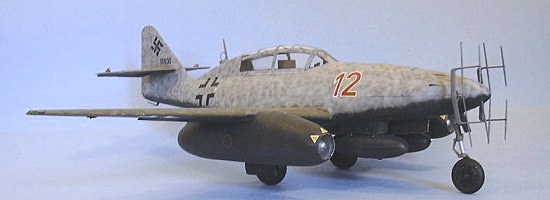 d
neither suffered from this problem. Modelers should check the upper wings of
their kits before proceeding with further assembly. If they are there, and I
suspect this may vary from kit to kit, the “valleys” can be dealt with as
described here, but it is much easier to do at the outset of assembly.
d
neither suffered from this problem. Modelers should check the upper wings of
their kits before proceeding with further assembly. If they are there, and I
suspect this may vary from kit to kit, the “valleys” can be dealt with as
described here, but it is much easier to do at the outset of assembly.
Decals:
I was able to piece together “Red 12" from other decal sheets, though I had to paint the red in the different numbers with Gunze-Sangyo Red 23, using a 00000 brush and a steady hand, to get a uniform look. I then pieced together the proper serial number from the kit decals, and then used the kit decals for the rest of the markings. With the airplane having been painted in the field, most all of the stencils appear not to have been replaced, other than the fuel markings and the step markings on the engine nacelles.
| CONCLUSIONS |
Other than the problem of the short-shot upper wings - a problem easily dealt
with - this kit is as good as the two previous Me-262s from Trumpeter - which
means it is very good indeed. It looks very nice sitting next to them, along
with the Revell He-162 and the Hasegawa Me-163. The kit is easy to assemble,
being complex but not complicated. The only reason for choosing either of
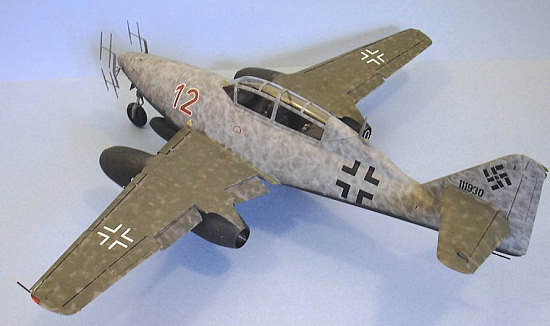 the earlier Revell or Hasegawa
kits would be strictly on price (I recently saw both at prices between $20-$30
at a local show), since the detail offered in the Trumpeter kit is so markedly
superior. The Me-262B-1a/U1 is a “must” for Luftwaffe fans even if it
didn’t single-handedly stop Bomber Command in 1945. Highly recommended.
the earlier Revell or Hasegawa
kits would be strictly on price (I recently saw both at prices between $20-$30
at a local show), since the detail offered in the Trumpeter kit is so markedly
superior. The Me-262B-1a/U1 is a “must” for Luftwaffe fans even if it
didn’t single-handedly stop Bomber Command in 1945. Highly recommended.
Thanks to Stevens International for the review kit.
February 2008
Reader Radu Brinzan (rbrinzan[at]hotmail.com) writes:
"Red 10" W.Nr 110635 is one of the aircraft captured by the
British. On page 462 of "Me262 Volume 3" by J. Richard Smith and Eddie J. Clark,
there are photos showing the aircraft, the red number 10, the serial number, as
well as Oblt. Kurt Welter and Lt. Georg Czypionka assiting a RAF pilot in the
cockpit. A profile of this aircraft appears on page 463 of the same book.
On page 59 of Model Art Special 367 "Messerschmitt Me262" there is a photo of
"Red 10" with British roundels.
One photo of "Red 10" appears in "Jet Planes of the Third Reich" (Page 290), on
page 65 of Merrick & Hitchcocks "The Official Monogram Painting Guide to German
Aircraft 1939 - 1945" and on page 214 of Manfred Griehl's "Jet Planes of the
Third Reich, The Secret Projects , Volume 2" (all from Monongram publications).
"Red 10" is not at all spurious. The only problem I can see with that decal
sheet is that the "0" in "10" is a tad too wide and squarish. "Red 10" was also
included in the Dragon and Heller kits.
BTW "Ltn. Kurta Weltera" is a Polish genitive of "Ltn. Kurt Welter" It is
evident that Trumpeter were inspired by a Polish language book where the line
read something like "the aircraft of Kurt Welter".
"Red 12" had solid upperwing camouflage. There is a photo on page 144 of "Scale
Aviation Modeller" (Volume 1 issue 3) that shows the aircraft from behind
(wearing British roundels). In this photo it is evident that the upper
camouflage is solid.
Also, the "nose" of the right engine pod was a replacement taken from another
aircraft and is painted RLM76 with a strip of dark colour at the top (or may be
natural metal). (see page 468 of the Creek and Smith book mentioned above).
The W.Nr of "Red 12" was 111980, according to Smith and Creek in "Jet Planes of
the Third Reich" and in "Me262 - Volume3".
Copyright ModelingMadness.com. All rights reserved. No reproduction in part or in whole without express permission. If you would like your product reviewed fairly and quickly, please
contact
the editor or see other details in the
Note to
Contributors.